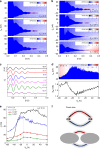Fermi-arc supercurrent oscillations in Dirac semimetal Josephson junctions
- PMID: 32123180
- PMCID: PMC7051961
- DOI: 10.1038/s41467-020-15010-8
Fermi-arc supercurrent oscillations in Dirac semimetal Josephson junctions
Abstract
One prominent hallmark of topological semimetals is the existence of unusual topological surface states known as Fermi arcs. Nevertheless, the Fermi-arc superconductivity remains elusive. Here, we report the critical current oscillations from surface Fermi arcs in Nb-Dirac semimetal Cd3As2-Nb Josephson junctions. The supercurrent from bulk states are suppressed under an in-plane magnetic field ~0.1 T, while the supercurrent from the topological surface states survives up to 0.5 T. Contrary to the minimum normal-state conductance, the Fermi-arc carried supercurrent shows a maximum critical value near the Dirac point, which is consistent with the fact that the Fermi arcs have maximum density of state at the Dirac point. Moreover, the critical current exhibits periodic oscillations with a parallel magnetic field, which is well understood by considering the in-plane orbital effect from the surface states. Our results suggest the Dirac semimetal combined with superconductivity should be promising for topological quantum devices.
Conflict of interest statement
The authors declare no competing interests.
Figures





Similar articles
-
4π-periodic Andreev bound states in a Dirac semimetal.Nat Mater. 2018 Oct;17(10):875-880. doi: 10.1038/s41563-018-0158-6. Epub 2018 Sep 17. Nat Mater. 2018. PMID: 30224782
-
π and 4π Josephson Effects Mediated by a Dirac Semimetal.Phys Rev Lett. 2018 Apr 27;120(17):177704. doi: 10.1103/PhysRevLett.120.177704. Phys Rev Lett. 2018. PMID: 29756844
-
Proximity-induced surface superconductivity in Dirac semimetal Cd3As2.Nat Commun. 2019 May 17;10(1):2217. doi: 10.1038/s41467-019-10233-w. Nat Commun. 2019. PMID: 31101813 Free PMC article.
-
Quantum oscillations from surface Fermi arcs in Weyl and Dirac semimetals.Nat Commun. 2014 Oct 20;5:5161. doi: 10.1038/ncomms6161. Nat Commun. 2014. PMID: 25327353
-
Evidence of topological surface state in three-dimensional Dirac semimetal Cd3As2.Sci Rep. 2014 Aug 20;4:6106. doi: 10.1038/srep06106. Sci Rep. 2014. PMID: 25139455 Free PMC article.
Cited by
-
Electrically controlled spin polarized current in Dirac semimetals.Sci Rep. 2021 Nov 2;11(1):21509. doi: 10.1038/s41598-021-01067-y. Sci Rep. 2021. PMID: 34728758 Free PMC article.
-
Obvious Surface States Connecting to the Projected Triple Points in NaCl's Phonon Dispersion.Front Chem. 2021 Nov 15;9:789522. doi: 10.3389/fchem.2021.789522. eCollection 2021. Front Chem. 2021. PMID: 34869236 Free PMC article.
-
Large superconducting diode effect in ion-beam patterned Sn-based superconductor nanowire/topological Dirac semimetal planar heterostructures.Nat Commun. 2024 Sep 30;15(1):8014. doi: 10.1038/s41467-024-52080-4. Nat Commun. 2024. PMID: 39349453 Free PMC article.
-
Magnetic field filtering of the boundary supercurrent in unconventional metal NiTe2-based Josephson junctions.Nat Commun. 2024 Mar 30;15(1):2785. doi: 10.1038/s41467-024-47103-z. Nat Commun. 2024. PMID: 38555347 Free PMC article.
-
Broad and colossal edge supercurrent in Dirac semimetal Cd3As2 Josephson junctions.Nat Commun. 2023 Oct 3;14(1):6162. doi: 10.1038/s41467-023-41815-4. Nat Commun. 2023. PMID: 37788988 Free PMC article.
References
-
- Hasan MZ, Kane CL. Colloquium: topological insulators. Rev. Mod. Phys. 2010;82:3045–3067. doi: 10.1103/RevModPhys.82.3045. - DOI
-
- Qi X-L, Zhang S-C. Topological insulators and superconductors. Rev. Mod. Phys. 2011;83:1057–1110. doi: 10.1103/RevModPhys.83.1057. - DOI
-
- Bernevig BA. It’s been a Weyl coming. Nat. Phys. 2015;11:698–699. doi: 10.1038/nphys3454. - DOI
-
- Armitage NP, Mele EJ, Vishwanath A. Weyl and Dirac semimetals in three-dimensional solids. Rev. Mod. Phys. 2018;90:015001. doi: 10.1103/RevModPhys.90.015001. - DOI
-
- Wan X, Turner AM, Vishwanath A, Savrasov SY. Topological semimetal and fermi-arc surface states in the electronic structure of pyrochlore iridates. Phys. Rev. B. 2011;83:205101. doi: 10.1103/PhysRevB.83.205101. - DOI
Grants and funding
LinkOut - more resources
Full Text Sources
Research Materials

